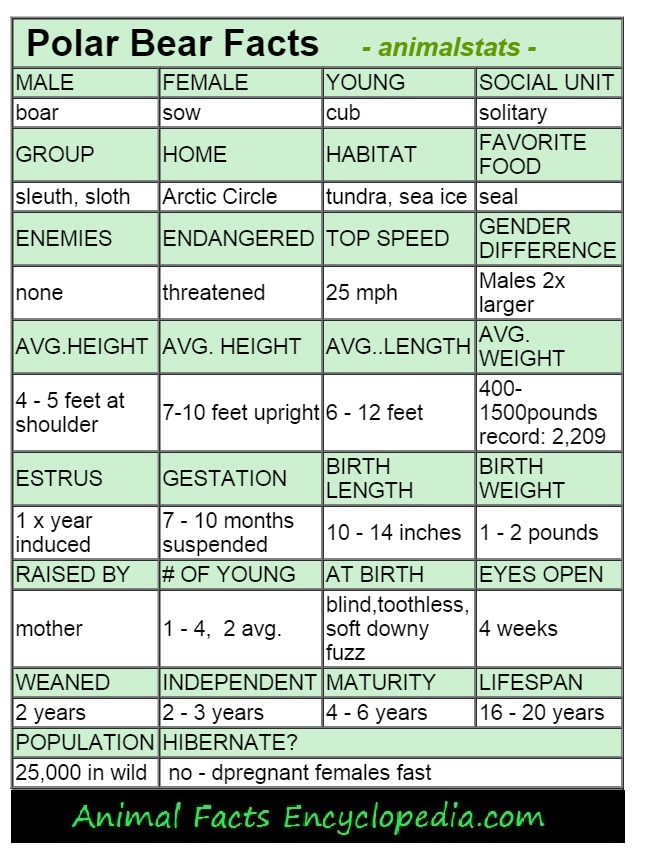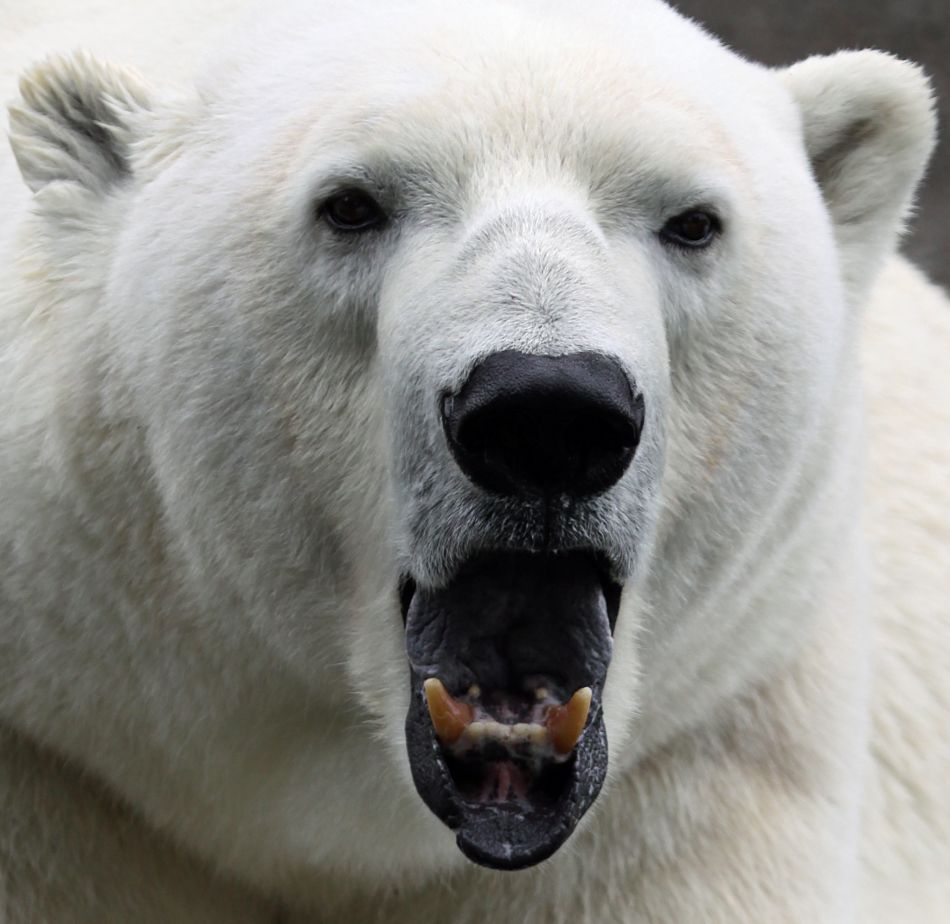polar bear Facts
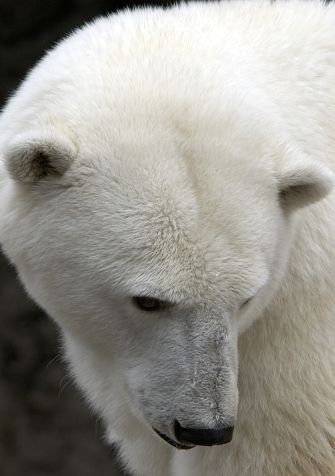 Portrait of a Polar Bear
Portrait of a Polar BearThe polar bear is the largest of the eight bear species, and the largest land dwelling carnivore. Polar bears live across the frozen northern cap of the world called the Arctic circle.
They may be found in the U.S.(Alaska), Norway, Canada, Russia, and Greenland on numerous frozen seas and bays. They spend the majority of their lives on water- either frozen sea ice cap or the ocean water itself, only rarely touching true solid earth in the short Arctic summer.
Having evolved from the brown or grizzly bear only some 100,00 years ago, the polar bear has specialized teeth, fur and foot structure, that allows it to survive and flourish in a harsh, frozen world.
The polar bears eyes have adapted to see well under water, and this huge bear can swim like a fish, diving if necessary, and holding its breath for up to two minutes at a time.
The semi-webbed front paws have become huge paddles in the sea, and sturdy, skid-free snowshoes on the ice cap.
Once a forest-dwelling omnivore, todays polar bear is a true carnivore, dining on very large prey like seal and elk, and is so dependent upon the sea that it is considered a marine mammal.
Capable of swimming dozens of miles without rest, and surviving for months in sub-zero temperatures without a meal, this is a very rugged animal, whose personality and playfulness defy its circumstance.
Bears are considered the most intelligent order of mammals after the great apes, the whales and the elephants, and although they have a fearsome reputation, polar bears actually rarely attack humans, and are not particularly aggressive with each other either.
They also make some of the most fiercely protective, loving and snuggly mothers in the entire animal kingdom. - Polar Bear Facts
The polar bear club
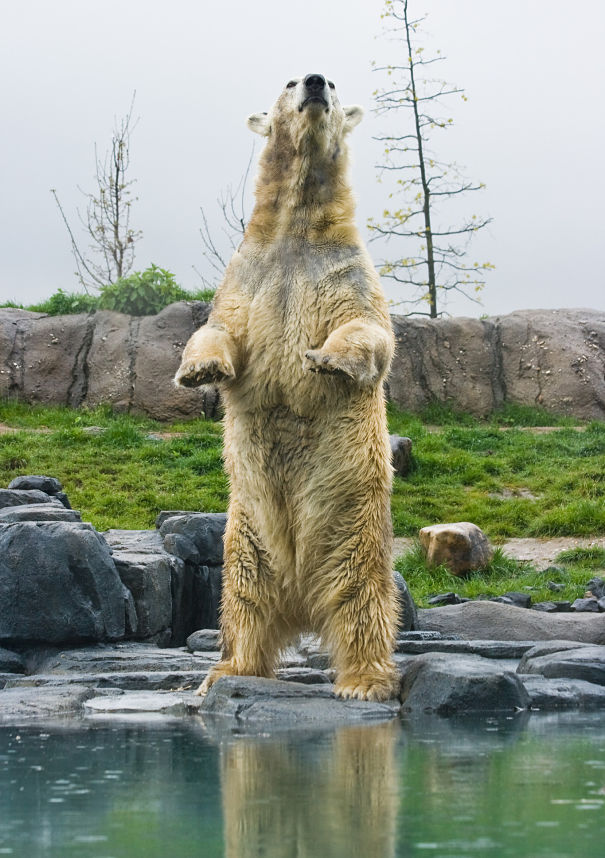

The polar bear has numerous special physical traits that allow it to survive in its Arctic environment.
While there is nothing unusual about regional factors causing evolutionary changes, what is unique about the polar bear is the relatively short length of time that these adaptions took place.
Fossil remains of polar bears only begin to appear about 100,000 years ago, when brown bears venturing north began to develop new biological tools that helped them cope.
With each successful evolutionary step, these bears were able to withstand and overcome more obstacles. Changes to coat color and the composition of the fur were probably some of the first adaptations.
Animals with lighter coloration were naturally more successful in the stark white conditions of the Arctic. Since they were able to avoid detection - an aid in both defense and hunting - light colored brown bears were more likely to survive, and the darker color was slowly bred out.
Other winter wonderland changes include an elongated body and head, tiny tail and ears, and massive feet for a snow-shoe effect, and for paddling in icy waters. - Polar Bear Facts
polar bear reproduction
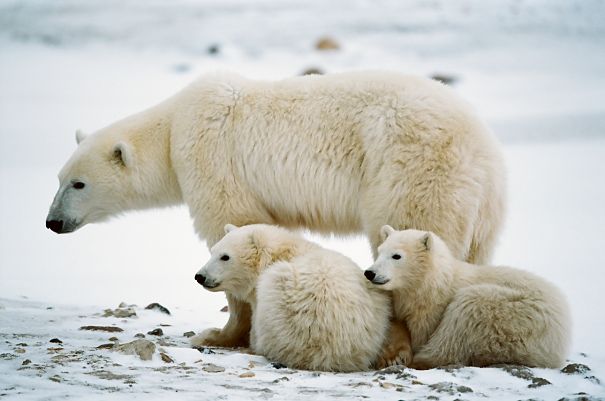 Polar bear mother and babies
Polar bear mother and babies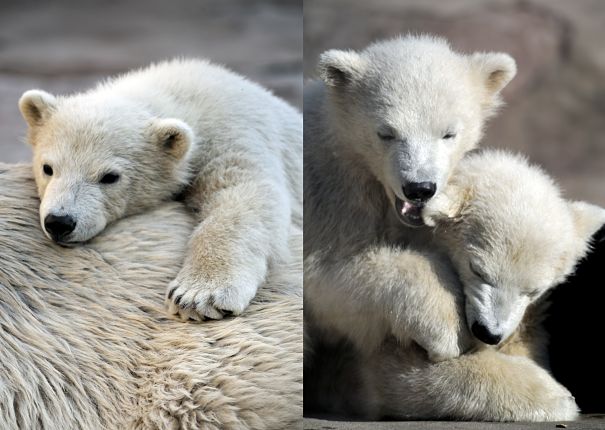 polar bear cubs
polar bear cubsPolar bears mate in the early spring when they come together at the seas edge during fine hunting season.
Once a male finds a receptive female he may have to fight off other males to retain her company. Occasionally these battles are very violent, but usually they are more of a wrestling match to demonstrate strength and superiority.
When paired up a couple may stay together for a week or more, courting, playing and copulating often. Interestingly, the female does not begin ovulation until after being courted, and it is these days of sexual activity that induce ovulation.
In another very unique aspect of polar bear reproduction, the females fertilized eggs will actually remain in a state of suspension, not growing or developing for the first four full months of pregnancy.
During these vital months, the female must eat as much as she can, and will usually double her body size, gorging on seal blubber to the tune of an additional 400 pounds before her babies even begin to grow! She will need this mass for the most critical time in any polar bears life, for what mother does now is truly astounding.
Sometime in the fall, September or November, the pregnant female will dig a massive snow cave for herself, and once she settles in, she will not venture out again for 4 to 5 months, not even to eat.
She does not hibernate, which would require a slowing of the heartbeat, but her metabolism does slow, and in the dark of the den, in the dead of winter, after 6 months of pregnancy, she gives birth to her tiny cubs.
Twins are typical, although up to four cubs are possible, and these babies are only about the size of a guinea pig.
Exhausted and starving, the mother emerges from the den in the spring with her vulnerable troop in tow, and sets out on a long journey back to the ice leads.
These first months are extremely dangerous times for cubs, and the survival rate is very poor.
After almost three years with mom, the young bears will leave her company. Polar bears have a very slow reproductive rate, and the care and skill of the mother bear is extremely critical.
Because the factor is so vital, the maternal instincts are extremely strong, and mother polar bears shower their cubs with love and affection. - Polar Bear Facts

what do polar bears eat?
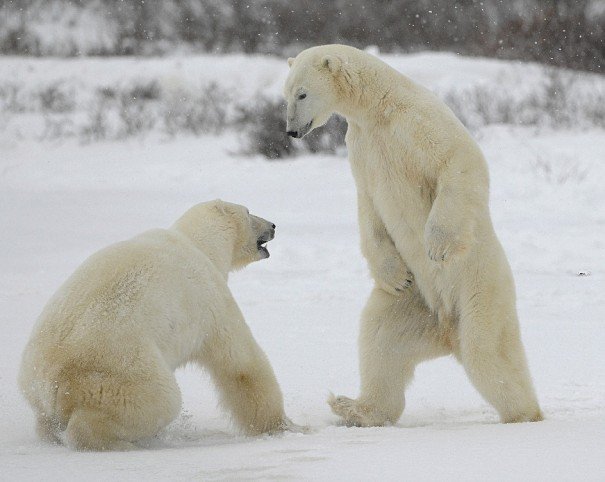 polar bears fighting
polar bears fighting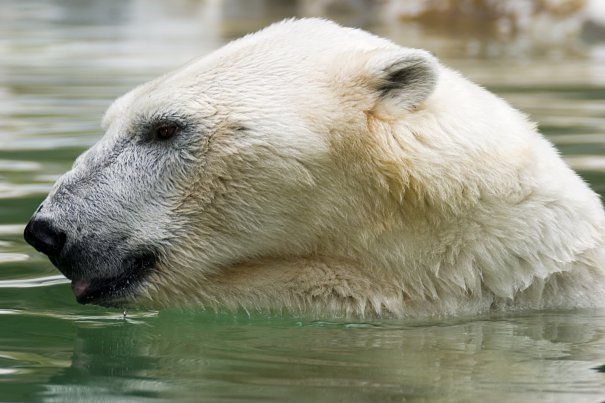
One major difference between polar bears and brown bears is diet.
Brown bears are omnivorous, eating a wide variety of foods including items as small as berries and moths.
The polar bear is almost entirely carnivorous. While they will eat things other than meat when available, they otherwise consume seals.
They don't even eat a large variety of seals, mostly just ringed seals and bearded seals. These two species of seals live under the ice during winter months, coming up for air at breathing holes throughout their range.
Occasionally the seals will come out and rest on the ice beside the hole, but usually they are nabbed by a lurking polar bear the moment they poke up out of the water for air.
During the spring these seals are forced to come out of the water to mate and raise their young. These weeks are critical for polar bears, especially females with cubs, who must hunt as many seals as they can to fatten up for the summer months.
Once the summer thaw comes, the polar bears world melts away and the dining room is closed.
Polar bears are forced to fast for two months, munching on whatever pittance they can find on dry land till the Arctic seas freeze over again.- Polar Bear Facts
 polar bear life
polar bear lifeclimate change and the polar bear
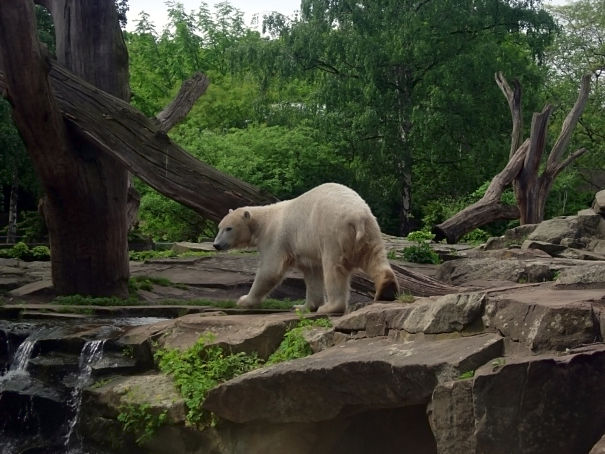
Today, our beautiful polar bear is in danger of extinction.
Climate change is causing massive changes to their environment. As the sea ice thaws earlier and earlier in the season, polar bears have a much shorter time frame within which to hunt the seals they exist on.
Normally the bears are able to fatten up on seal pups during springtime. It has always been a race for them to gorge as much as possible because as spring comes into bloom the sea ice melts, and the seals return to open water.
Traditionally, large populations of polar bears have gone without food for the summer, but have had enough fat stores to survive.
Now, with a shorter winter, polar bears are starving to death, and populations, particularly in the southern regions, have declined as the climate rises.
A polar bear in a green environment is probably a hungry bear, and their environment is getting greener every year. Because of this, the polar bear may soon be in critical danger of extinction in the wild - Polar Bear Facts.
a few more polar bear facts
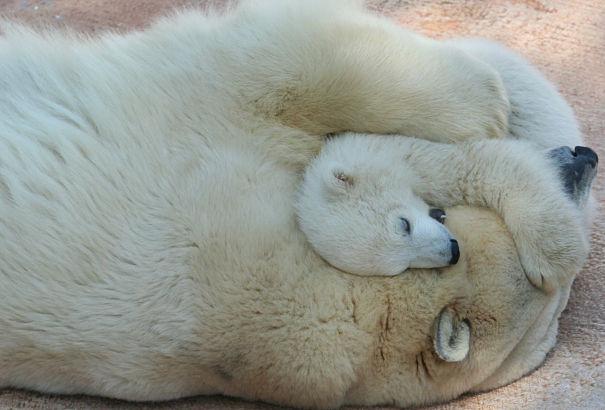 polar bear hugging her cub
polar bear hugging her cub- The polar bear is the largest land carnivore
- Polar bears spend about 90% of their lives in - or on- the water, walking, running, and rolling around on the frozen ice cap, which is - after all- not land, but sea!.
- Polar bears and brown bears occasionally inter-breed in the wild. Some think their reddish-colored offspring are mistaken for Bigfoot!
- A polar bears fur is not white - the hairs are actually translucent
- Polar bears have black skin.
- Polar bears can smell a seal coming up for air over 1/2 a mile away.
- A new-born baby polar bear is smaller than a guinea pig Amazing Polar Bear Facts!
Scientific Classification:
| Polar Bear Facts - animalstats - | |||
|---|---|---|---|
| MALE | FEMALE | YOUNG | SOCIAL UNIT |
| boar | sow | cub | solitary |
| GROUP | HOME | HABITAT | FAVORITE FOOD |
| sleuth, sloth | Arctic Circle | tundra, sea ice | seal |
| ENEMIES | ENDANGERED | TOP SPEED | GENDER DIFFERENCE |
| none | threatened | 25 mph | Males 2x larger |
| AVG.HEIGHT | AVG. HEIGHT | AVG..LENGTH | AVG. WEIGHT |
| 4 - 5 feet at shoulder | 7-10 feet upright | 6 - 12 feet | 400-1500pounds record: 2,209 |
| ESTRUS | GESTATION | BIRTH LENGTH | BIRTH WEIGHT |
| 1 x year induced | 7 - 10 months suspended | 10 - 14 inches | 1 - 2 pounds |
| RAISED BY | # OF YOUNG | AT BIRTH | EYES OPEN |
| mother | 1 - 4, 2 avg. | blind,toothless, soft downy fuzz | 4 weeks |
| WEANED | INDEPENDENT | MATURITY | LIFESPAN |
| 2 years | 2 - 3 years | 4 - 6 years | 16 - 20 years |
| POPULATION | HIBERNATE? | ||
| 25,000 in wild | no - dpregnant females fast | ||
see more animal extreme closeups
Recent Articles
-
African Animals - Animal Facts Encyclopedia
Oct 11, 16 10:27 PM
African Animals facts photos and videos..Africa is a wonderland for animal lovers, and a schoolroom for anyone who wants to learn about nature, beauty and the rhythm of life -
Baboon Facts - Animal Facts Encyclopedia
Oct 11, 16 10:26 PM
Baboon facts, photos, videos and information - Baboons are very distinctive looking monkeys with long, dog-like snouts and close set eyes. -
Great Apes Facts - Animal Facts Encyclopedia
Oct 11, 16 10:25 PM
Great apes facts, photos and videos..Human beings did not evolve from chimpanzees, modern chimps and gorillas do not appear in the fossil records until much more recently than homo sapiens..
